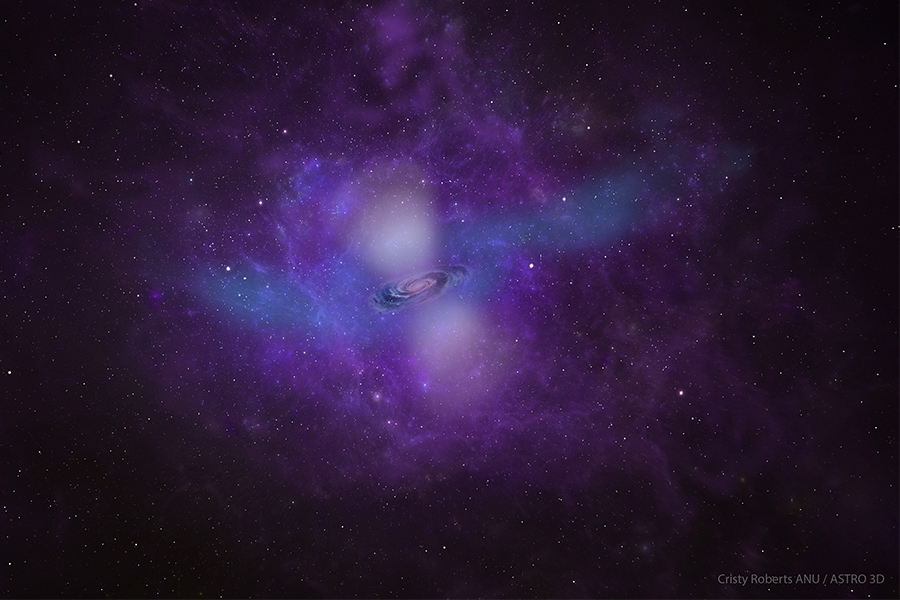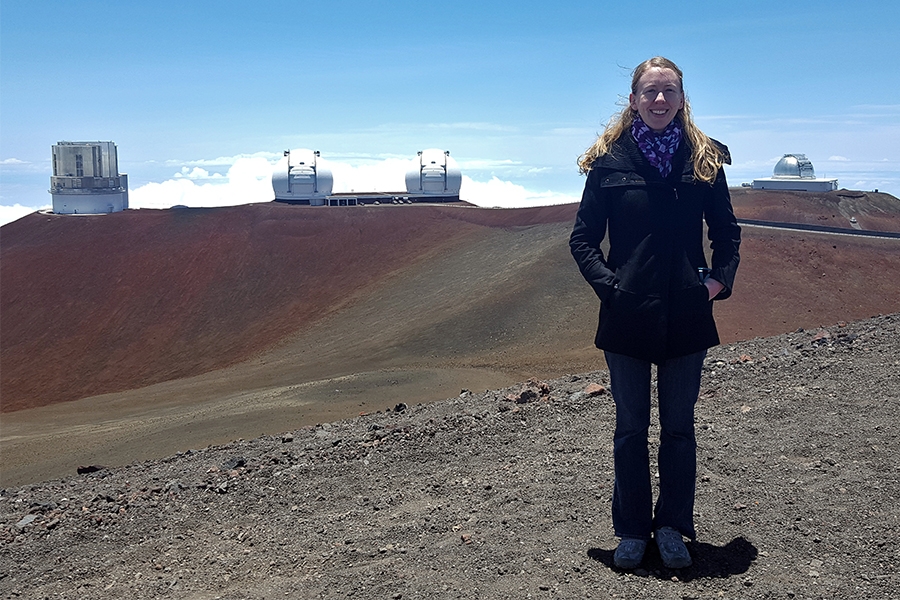
NORMAN, OKLA. – Research led by Nikole Nielsen, an assistant professor of astrophysics and cosmology at the University of Oklahoma, has been published in the journal Nature Astronomy that examines, pixel-by-pixel, the highest resolution photograph of the halo of gasses surrounding a star-bursting galaxy.
“When people think of galaxies, they think of stars and dust and gas. That’s the interstellar medium,” Nielsen said. “Just outside of the galaxy is the circumgalactic medium. Known as CGM, it’s a collection of very hot gasses, which can reach temperatures of several tens of thousands of degrees Kelvin, that serve as the boundary between the galaxy and a cosmic web that interconnects galaxies. Until now, researchers had never seen where a galaxy ends and where its CGM begins.”
Nielsen and her fellow scientists used the Keck Cosmic Web Imager to observe the CGM of a galaxy 270 million light years away. Using the 10-meter telescope at the Keck Observatory on the Mauna Kea volcano in Hawaii – the most sensitive instrument of its kind – they detected a cloud of glowing gas that extended 100,000 light years away from the galaxy.
“As we look at this CGM, we examined how the gas changed with distance from the galaxy. As the distance increased, the gas became fainter at a slower rate,” she said. “As gasses left the galaxy, they also seemed to be shocked when they hit the CGM, changing their physical condition. These changes represent the boundary between the interstellar medium of the galaxy and its CGM.”
Traditionally, scientists observed the CGM by measuring the light from a single quasar that is absorbed by the gas in front of it. This small, pencil-like beam doesn’t give researchers much data, however.
“Before this breakthrough, we would have one spectrum point per galaxy and one measurement per CGM. Now we have thousands thanks to the Keck Cosmic Web Imager,” she said. “The KCWI basically takes a picture with thousands of tiny pixels, and each of those pixels has its own spectrum of light. By spreading out this spectrum, we can essentially observe thousands of light points simultaneously and observe the halo of matter around a galaxy.
“Having one of the first papers in Nature Astronomy is significant and exciting,” she added. “Hopefully this discovery and methodology will allow us to gather a large sample of these galaxies, including our own Milky Way galaxy, and develop maps of their CGMs.”
This discovery could help astronomers answer the question of how galaxies evolve and has been recognized by the National Academies of Science, Engineering and Medicine’s 2020 Astronomy Decadal Survey as a key path forward in the field. This survey identifies scientific priorities, opportunities and funding recommendations for the next 10 years of astronomy and astrophysics.
Read the full study, “An emission map of the disk–circumgalactic medium transition in starburst IRAS 08339+6517,” published in Nature Astronomy, DOI no. 10.1038/s41550-024-02365-x.

About the University of Oklahoma
Founded in 1890, the University of Oklahoma is a public research university located in Norman, Oklahoma. As the state’s flagship university, OU serves the educational, cultural, economic and health care needs of the state, region and nation. OU was named the state’s highest-ranking university in U.S. News & World Report’s most recent Best Colleges list. For more information about the university, visit ou.edu.
Three University of Oklahoma graduate students have been named winners of the 2025 Three Minute Thesis competition, which challenges participants to explain their research in three minutes to a non-specialist audience.
Sarah Sharif, a researcher with the University of Oklahoma, has been awarded funding from the U.S. Department of Defense (DoD) to create innovative light detectors that pick up mid-wave and long-wave infrared signals at higher temperatures than previously considered achievable.
A team from OU and WVU recently earned a five-year, $3.5 million grant from the National Institutes of Health to study how concept cigarillos influence the potential for addiction. The results will be used to inform the FDA’s impending flavor ban on cigar products and could have wider-reaching implications for other tobacco products that come in flavors, such as e-cigarettes and tobacco-free nicotine pouches.